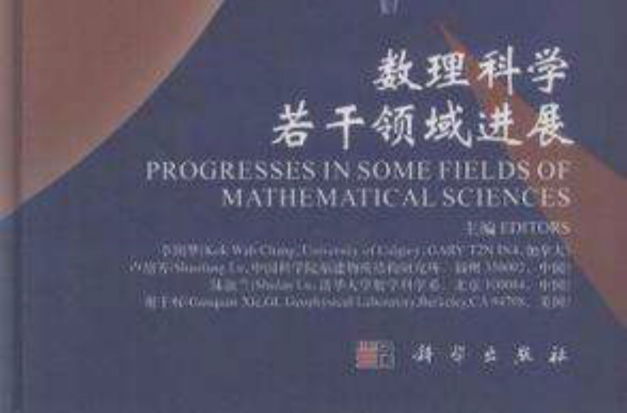《數理科學若干領域進展》是2011年11月科學出版社出版的圖書,作者是章國華、盧紹芳、陸淑蘭、謝乾權。
基本介紹
- 書名:數理科學若干領域進展
- 作者:章國華、盧紹芳、陸淑蘭、謝乾權
- ISBN:9787030327871
- 出版社:科學出版社
- 出版時間:2011年11月
- 裝幀:精裝
- 開本:16
內容簡介,目錄,
內容簡介
數理科學是數學與其他學科的邊緣交叉科學,包括數位技術,它在信息社會中扮演著越來越重要的角色,高科技產品本質上幾乎都是數位技術的硬化。數學在研究物理科學、事理科學、管理科學、生理科學、心理科學和哲理科學的複雜問題中是不可或缺的分析手段,它們的交叉結緣豐富著數理科學的內容。本書主體是數學邊緣性科學論文,反映了範圍廣泛的當代數學與其他科學交叉的思想和研究成果。本書對範圍廣泛的研究活動給出了評價,論述了最新的成就,提出了某些未來研究的方向。郭友中教授作為這些領域的領頭專家,他的貢獻將得到慶賀,前言和後語都將用來專門介紹他的科學成就和事業人生。聯結各章使之成為整體的基本主題是來自偏微分方程和動力系統的深刻思想和專精技巧。
本書可供數學、力學、物理學、工程科學、生命科學、信息科學、金融科學、交叉科學各分支的研究者和教育工作者參考,也可以作為自然科學其他各分支研究者的參考書。
目錄
主編的話
Preface
前言
數學與數理科學
1.1 數學與神經系統
1.1.1 數字的畫、空間的歌
1.1.2 數學分化、運動統一
1.1.3 協調發展、神經系統
1.2 數學與三次危機
1.2.4 現代數學時期
1.2.5 第三次危機尚未結束
1.2.1 數學萌芽時期
1.2.2 初等(常量)數學時期
1.2.3 高等(變數)數學時期
1.3 數學與套用數學
1.3.1 套用數學源自德國
1.3.2 觀點分歧接踵而至
1.4 數學與數學物理
1.4.1 數理科學
1.4.2 數學模型
1.4.3 數學物理在中國
1.5 數理科學強調的是邊緣研究
1.5.1 數學物理名稱的時代背景
1.5.2 數理科學強調的是邊緣研究
1.6 數理科學與思維科學
2 MEMS 曲梁驅動器的大變形電動力學特性分析 2.1 引言
2.2 理論分析
2.2.1 模型的描述
2.2.2 控制方程
2.3 數值計算方法
2.4 數值結果
2.4.1 結果的驗證
2.4.2 微曲梁驅動器分析
2.5 結論
參考文獻
3 OneNon^standard Nonhomogeneous Heat Equation:Identification and Regularization for the Inhomofeneous Term 3.1 Introduction
3.2 Uniqueness
3.3 Regularization
Referenes
隨機動力系統與現代套用數學
4.1 引言
4.2 動力系統與現代套用數學
4.3 隨機動力系統
4.3.1 隨機動力系統
4.3.2 隨機動力系統中的一些重要概念
4.3.3 隨機動力系統中大家關注的一些問題
4.4 例子
4.4.1 地球、氣候與環境
4.4.2 醫學成像與疾病檢測
4.4.3 金融市場與投資風險
參考文獻
5 Regularizatio Nof Ill^posed Cauchy Problem Associated with Partial Differential Operator with Constant Coefficients 5.1 Introduction
5.2 Case of abstract differential operators
5.3 Case of partial differential operators
References
6 帶時間窗的允許工件重複中斷情況下排序問題 6.1 引言
6.2 到達時間為不可支配型
6.2.1 到達時間為確定型和靜態型
6.2.2 到達時間為隨機型和動態型
6.2.3 套用實例
6.3 到達時間為可支配型
6.4 總結
參考文獻
7 A New GL Anis otropicand Isotrapic Invisible Cloak Without Exceeding Light Speed Wave 7.1 Introduction
7.2 A new GL EM invisible cloak class
7.2.1 GL EM cloak without exceeding light speed wave
7.2.2 The GL isotropic invisible cloak without exceeding light speed violation
7.2.3 The anisotropic model GLM^2 EM cloak
7.3 GL EM modeling and Inversion in spherical system
7.3.1 Three dimension spherical Maxwell equation
7.3.2 One dimensional radial Maxwell equation
7.3.3 New radial EM integral equation
7.3.4 New GL modeling for radial EM wave propagation
7.4 Properties of GL invisible cloak
7.5 T he proof of the property 7.5
7.6 No scattering from GL cloak to disturb the exterior wave
7.6.1 The continuous of the solution of ODE with the variable coefficient
7.6.2 No scattering from GL cloak to disturb the exterior wave
7.6.3 No scattering from coordinate transform cloak to disturb the exterior wave
7.7 Full electromagnetlc wave propagation through GL cloak and has no exceeding light speed
propagation
7.8 The conclusion
References
The Crack Problem in Bonded Materials
8.1 Introduction
8.2 Boundary conditions and solution of the problem
8.3 Criterion of brittle fracture
References
一類隨機矩陣特徵值的估計及其套用
9.1 引言
9.2 一類隨機矩陣的特徵值估計
9.3 在間斷動力系統中的套用
參考文獻
10 A Perspective on Dynamical Systems under Non^Gaussian Fluctuations 10.1 Motivation
10.2 Random dynamical systems with Lévy motions
10.2.1 Random dynamical systems
10.2.2 Lévy motions
10.2.3 Differential equations driven by Lévy motions
10.3 Invariant manifolds
10.3.1 Converting a Marcus canonical equation to a random equation
10.3.2 Random stable manifolds
10.3.3 Random stable and unstable manifolds
References
11 Synthesis and StructuralCharacterization of the Novel Cluster Compound 11.1 Introduction
11.2 Results and discussion
11.3 Conclusion
11.4 Experim ental section
11.5 Acknowledgement
References
12 Pansystems Logoi:Mathematics & Pan^ Mathematics with Hilbert Problems 12.1 Introduction:panmathematics
12.2 Pansystems sublation
12.3 Pansystems traffics kinematics Cintelligence
12.4 Pansystems mathematics:an epitome Pansystems Maxims 200
12.5 Pansystems approach to Hilbert problems
12.6 00xy
12.7 Pansystems topology & Wfuzziness
12.8 History mega wave & pansystems sublation
References
13 Researches on Graphical Design Method of Concurrent Software 13.1 Introduction
13.2 Basic assumptions
13.3 Relations between communications
13.4 Definition of concurrent design language CONDL
13.4.1 Communication
13.4.2 Selection
13.4.3 Communication successive relation and successive relation sequence
13.4.4 Nesting communication relation
13.4.5 Iteration
13.5 Graphical representation of CONDL
13.6 Condlas:a concurrent softw are design tool
Referencesb
14 GLLH EM Invisible Cloak with Novel Front Branching and without Exceed Light Speed Violation 14.1 Introduction
14.2 GLLH EM cloak without exceed light speed
14.2.1 GLLH EM invisible cloak
14.2.2 Invisible functions of GLLM EM cloak
14.3 GL EM cloak inversion
14.3.1 3D EM integral equation
14.3.2 Functionx in GL EM cloak inversion
14.3.3 GL EM cloak exterior inversion
14.3.4 GL EM cloak inner inversion
14.3.5 Constraint in GLLH EM cloak inversion
14.3.6 GL EM cloak inversion
14.4 Novei EM propagation in GLLH EM cloak without exceed light speed
14.4.1 The simulation model of the GLLH EM cloak
14.4.2 Novel electric wave propagation
14.5 Invisible properties of GLLH EM cloak
14.5.1 The invisibility of the GLLH EM cloak
14.5.2 Without exceed light speed violation
14.5.3 Wave front branching
14.6 GLLH EM double layer cloak
14.7 EM wave field decay to zero inverse radial
14.8 History and discussion
14.9 Conclusion
References
系統演化與演化經濟學
15.1 緒論
15.2 經濟學演化簡史
15.2.1 經濟學演化4個階段
15.2.2 國外演化經濟學研究
15.2.3 國內演化經濟學研究
15.3 系統演化與改革開放
15.3.1 系統目標功能與結構
15.3.2 開放系統與複雜系統
15.4 能量轉換與信息轉換
15.4.1 三種人與三個時代
15.4.2 三次產業與三個世界
15.5 希爾伯特問題與演化經濟學公理化
15.5.1 4個假定
15.5.2 4個原理
15.5.3 4個方法
15.6 時空變化與關係分級
15.6.1 場與時空變化
15.6.2 量子化與關係分級
15.6.3 宇宙演化與經濟學的進一步數學化
15.7 對稱破缺與制度演進
15.7.1 對稱性與守恆律
15.7.2 對稱性破缺與物質六態
15.7.3 對稱破缺與制度演進是經濟成長的決定因素
15.7.4 信息對稱破缺與結構自閉是前赴後繼的制度根源
15.8 古典熱力學與邊際革命
15.8.1 外微分形式與熱力學焓
15.8.2 熱力學函式與熵增原理
15.8.3 鑽石悖論與邊際革命
15.8.4 對偶與測不準原理
15.8.5 極值原理與貧富分布
15.9 耗散結構與熵經濟學
15.9.1 熵流與熵產出
15.9.2 熱力學第二階段——倒易律
15.9.3 熱力學第三階段——耗散結構
15.9.4 自組織系統
15.9.5 對稱破缺與時空有序
15.10 突變理論與災害經濟學
15.10.1 平衡與非平衡相變
15.10.2 Thom的方法
15.10.3 災害經濟學
15.11 協同理論與競爭優勢理論
15.11.1 自組織理論
15.11.2 序參量與絕熱消去
15.11.3 特徵值與門檻理論
15.12 Nash平衡與博弈革命
15.12.1 Nash平衡與Nash定理
15.12.2 共同優超與PARETO優勢
15.12.3 改革深水區與台灣選舉
15.13 特徵阻抗與長波理論
15.13.1 長波、創新與新經濟
15.13.2 經濟混沌(economic chaos)
15.13.3 特徵阻抗與傳輸相似性
15.13.4 一種長波理論模型
15.14 現代場論與混沌革命
15.14.1 混沌革命
15.14.2 數理經濟學和物理學的啟示
15.15 演化與非演化經濟學
15.15.1 線性經濟系統——非演化經濟學
15.15.2 非線性經濟系統——演化經濟學
15.15.3 微觀演化與巨觀演化經濟學
4S 一體化系統
16.1 引言
16.2 研究現狀
16.3 4S一體化系統(本系統)
16.3.1 工作原理
16.3.2 技術實現
16.3.3 功能的定義與實現
16.4 4S一體化系統與現有系統的對比
16.4.1 4S一體化系統的RTS功能與傳統形變測量系統的對比
16.4.2 4S一體化系統的RTS功能與國際先進的GPS測量系統的對比
16.4.3 4S一體化系統的道路自動測繪功能與國際領先的3S集成道路自動測繪系統的對比

